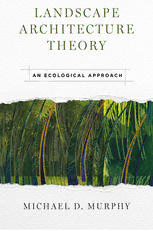
Landscape Architecture Theory: An Ecological Approach PDF
Preview Landscape Architecture Theory: An Ecological Approach
L A N D S C A P E A R C H I T E C T U R E T H E O R Y AN ECOLOGICAL APPROACH M I C H A E L D . M U R P H Y Island Press’ mission is to provide the best ideas and information to those seeking to understand and protect the environment and create solutions to its complex problems. Join our newsletter to get the latest news on authors, events, and free book giveaways. Click here to join now! LANDSCAPE ARCHITECTURE THEORY LANDSCAPE ARCHITECTURE THEORY An Ecological Approach Michael D. Murphy Washington | Covelo | London Copyright © 2016 Michael D. Murphy All rights reserved under International and Pan-American Copyright Conventions. No part of this book may be reproduced in any form or by any means without permission in writing from the publisher: Island Press, 2000 M St. NW, Suite 650, Washington, DC 20036 Island Press is a trademark of The Center for Resource Economics. Portions of this book first appeared in Landscape Architecture Theory: An Evolving Body of Thought by Michael D. Murphy. Long Grove, IL: Waveland Press, 2005. Keywords: architecture, behavioral theory, climate, cognitive needs, collaboration, commodity, conative needs, construction, creative thinking, critical thinking, cultural diversity, design, de- sign programming process, ecology, ecosystem management, Fibonacci, geology, golden mean, health, horticulture, landscape architecture, maintenance, pedestrians, planning, problem solv- ing, procedural theory, resilience, substantive theory, sustainability, system performance, utility, urban development, values, visualization Library of Congress Control Number: 2016941252 Printed on recycled, acid-free paper Manufactured in the United States of America 10 9 8 7 6 5 4 3 2 1 Contents Preface ix Acknowledgments xiii Part I Introduction Chapter One Introduction 3 Part II Substantive Theory Chapter Two Substantive Theory 25 Chapter Three The Biophysical Landscape 55 Chapter Four The Human Landscape 97 Chapter Five Design Purpose 133 Chapter Six Design Form 149 Part III Procedural Theory Chapter Seven Design Process 185 Chapter Eight Problem Definition 217 Chapter Nine Design Collaboration 243 Chapter Ten Design Thinking 263 Chapter Eleven Conclusion 279 Bibliography 289 Index 315 vii Preface The art of progress is to preserve order amid change, and to preserve change amid order. —Alfred North Whitehead During the early part of the twentieth century, it was commonplace to hear farmers, as an expression of their industry and energy, boast of hav- ing “worn out” several farms during their lifetime. Although such com- ments are no longer heard today, the essence of this notion lingers as a shadowy background in our collective consciousness, a legacy of our historical experience. When we consider that, each year, productive agricultural soil contin- ues to be lost from the United States at a rate ten times faster than natural regeneration, or that each of us sends a ton of waste to the landfill, it is apparent that we have not completely abandoned the idea that critical landscape resources, as well as the space to dispose of them at the end of their (presumed) useful life, remain abundant. Our attitudes—and, as a consequence, our understanding—lag behind what science tells us about the relationships between society and the landscape. Conceptually, the landscape is complicated: it may be described as a natural scene, as a designed setting, or as an ecological system for orga- nizing energy and matter. Although we think of the landscape as a place, it is better understood as a process of physical and biological evolution. Through design, we act to manage the continuing process of land- scape evolution—sometimes by accelerating the process, sometimes by slowing it down, and sometimes by changing its course—to improve the conditions of the environment in ways that enhance our own quality of life and create meaningful and compelling places as the setting for human activity. Today, as we gain increasing power to change the landscape, we also increase our responsibility to do so wisely, to protect the landscape as ix
